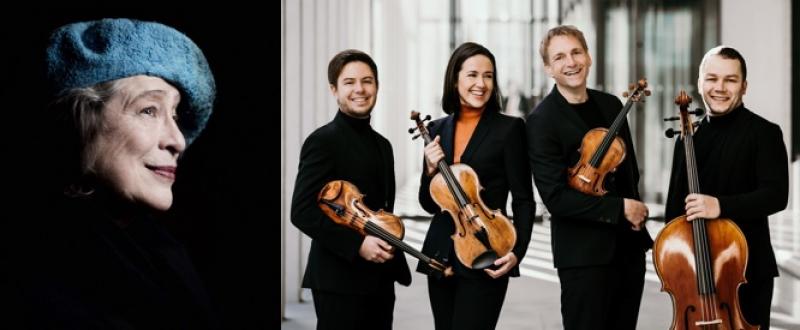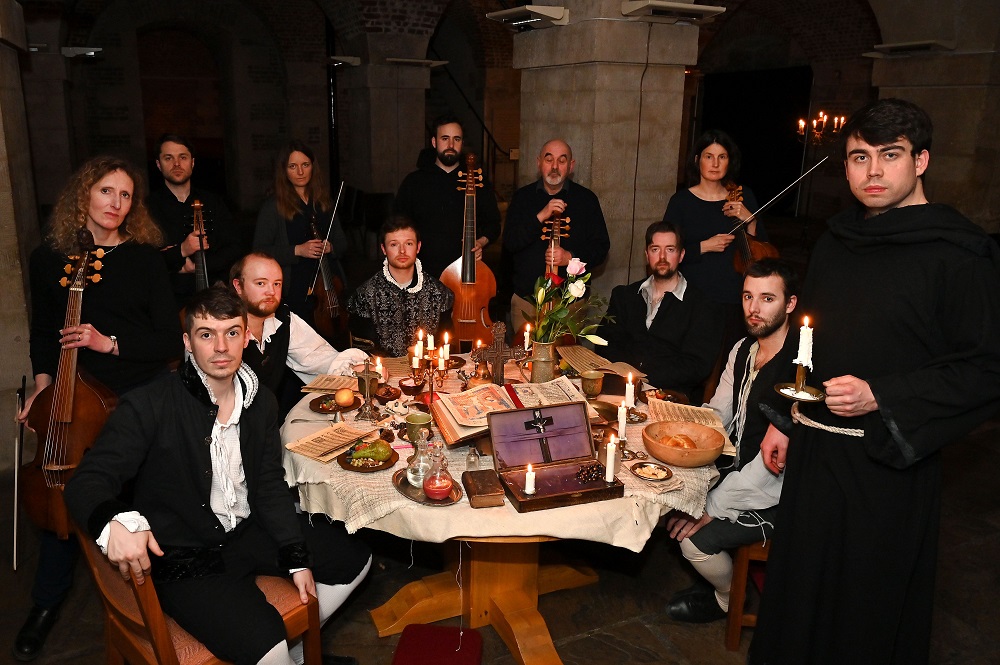Leonskaja, Staatskapelle Streichquartett, Wigmore Hall / Secret Byrd, St Martin-in-the-Fields review - genuine versus theatrical | reviews, news & interviews
Leonskaja, Staatskapelle Streichquartett, Wigmore Hall / Secret Byrd, St Martin-in-the-Fields review - genuine versus theatrical
Leonskaja, Staatskapelle Streichquartett, Wigmore Hall / Secret Byrd, St Martin-in-the-Fields review - genuine versus theatrical
Brahms illuminated, Byrd rather more obliquely showcased

It’s dangerous to claim a sense of absolute rightness about a musical performance; that could mean no more than responding to an interpretation which happens to chime with your own subjective expectations. Yet I’m happy to stick my neck out and say that the partnership of septuagenarian pianist Elisabeth Leonskaja with the young Staatskapelle Quartet of Berlin felt absolutely right in works by Brahms that cry out in every bar for authentic musicianship (★★★★★).
Maybe that’s true of all the great chamber works. But Brahms draws on a unique wellspring of original melody and rhythmic ingenuity in profoundly logical order. That may be profuse, as in the F minor Piano Quintet which rounded off two concerts of infinite riches and the A major Piano Quartet, the Second, which stunned us all with its invention in this team’s previous Brahms at the Wigmore, or relatively spare, in the case of the Third, the C minor, which had the fullest focus in this event’s first half. The great pianist seemed happy and serene with her relatively modest role here; the limelight fell above all on cellist Claudius Popp in one of the greatest of those original melodies, soaring in the Andante.
As so often with Brahms, it would be hard to guess the work’s place in his output: in this case, an inspiration of the 1850s, imbued with the muse-like influence of Clara Schumann, reworked in 1873. Rightness here is partly a question of settling on natural tempi – especially fine in the Allegro comodo of the finale.
All-Brahms programmes never seem to fail in the right hands, and the contrast with the Piano Quintet was all we needed. The ideas and the imagery – wood-magic especially in the way Leonskaja handled the second theme of the opening Allegro non troppo – tumbled forth, without haste, and simply rolling in the way this pianist knows how to do in the laid-back originality of the Andante, un poco adagio. Explosiveness was kept in check until the massive optimisms of the big-boned Scherzo and the turbulences of the finale. From their sheer physical energy, you’d be inclined to think of all five players as in their 20s if you simply listened. Poetic subtlety returned in the encore, the central "Dumka" movement of Dvořák's Second Piano Quintet. Music-making like this really does spoil one for everything else.  Not that there were any comparisons to be made with the one-off novelty of “Byrd Revealed” in the crypt of St Martin-in-the-Fields the previous evening, masterminded by Bill Barclay of Concert Theatre Works (pictured above by Mark Allan: Fretwork and The Gesualdo Six; ★★★). This was a bold way to mark the 400th anniversary of the British Catholic composer’s death. Context was minimal for those of us who had our tickets taken five minutes before the start: we were told we could walk around at will, observe the Tudorbethan objects on the main table, steer clear of the candles and not touch the players or singers, be aware that there would be total darkness for one minute. But because we apparently missed a briefing from the singers and weren't pointed in the direction of the specially installed gallery, we could only guess at the sequence beyond the Five-Part Mass and conjecture that the scary banging which broke into the last bars of the Five-Part Mass’s Agnus Dei represented persecution of Catholics.
Not that there were any comparisons to be made with the one-off novelty of “Byrd Revealed” in the crypt of St Martin-in-the-Fields the previous evening, masterminded by Bill Barclay of Concert Theatre Works (pictured above by Mark Allan: Fretwork and The Gesualdo Six; ★★★). This was a bold way to mark the 400th anniversary of the British Catholic composer’s death. Context was minimal for those of us who had our tickets taken five minutes before the start: we were told we could walk around at will, observe the Tudorbethan objects on the main table, steer clear of the candles and not touch the players or singers, be aware that there would be total darkness for one minute. But because we apparently missed a briefing from the singers and weren't pointed in the direction of the specially installed gallery, we could only guess at the sequence beyond the Five-Part Mass and conjecture that the scary banging which broke into the last bars of the Five-Part Mass’s Agnus Dei represented persecution of Catholics.
Much the most successful number was what came out of this, Byrd’s elegy on the death of his master, Thomas Tallis, “Ye Sacred Muses”, exquisitely sung by the Gesualdo Six countertenor Guy James with the players of Fretwork. They were impeccable throughout, but the voices, ruthlessly exposed in a dry acoustic, proved variable in technique (nothing that can’t be sorted with a bit more training on the part of one of them). The full mass having been punctuated with instrumental fantasias that allowed a modicum of dance, we now – I learn in retrospect – moved into “Communion” with “Infelix ego” and the familiar “Haec dies”; now I understand why we were given bread and tomato soup (very welcome). Still, the overall experience was less than the sum of its parts. There’s time for fine-tuning of context as the event goes on tour.
Share this article
Add comment
The future of Arts Journalism
You can stop theartsdesk.com closing!
We urgently need financing to survive. Our fundraising drive has thus far raised £49,000 but we need to reach £100,000 or we will be forced to close. Please contribute here: https://gofund.me/c3f6033d
And if you can forward this information to anyone who might assist, we’d be grateful.

Subscribe to theartsdesk.com
Thank you for continuing to read our work on theartsdesk.com. For unlimited access to every article in its entirety, including our archive of more than 15,000 pieces, we're asking for £5 per month or £40 per year. We feel it's a very good deal, and hope you do too.
To take a subscription now simply click here.
And if you're looking for that extra gift for a friend or family member, why not treat them to a theartsdesk.com gift subscription?
more Classical music
 theartsdesk at the New Ross Piano Festival - Finghin Collins’ musical rainbow
From revelatory Bach played with astounding maturity by a 22 year old to four-hand jazz
theartsdesk at the New Ross Piano Festival - Finghin Collins’ musical rainbow
From revelatory Bach played with astounding maturity by a 22 year old to four-hand jazz
 First Person: Manchester Camerata's Head of Artistic Planning Clara Marshall Cawley on questioning the status quo
Five days of free events with all sorts of audiences around Manchester starts tomorrow
First Person: Manchester Camerata's Head of Artistic Planning Clara Marshall Cawley on questioning the status quo
Five days of free events with all sorts of audiences around Manchester starts tomorrow
 Goldscheider, Brother Tree Sound, Kings Place review - music of hope from a young composer
Unusual combination of horn, strings and electronics makes for some intriguing listening
Goldscheider, Brother Tree Sound, Kings Place review - music of hope from a young composer
Unusual combination of horn, strings and electronics makes for some intriguing listening
 theartsdesk Q&A: composer Donghoon Shin on his new concerto for pianist Seong-Jin Cho
Classical music makes its debut at London's K-Music Festival
theartsdesk Q&A: composer Donghoon Shin on his new concerto for pianist Seong-Jin Cho
Classical music makes its debut at London's K-Music Festival
 Helleur-Simcock, Hallé, Wong, Bridgewater Hall, Manchester review - moving lyricism in Elgar’s concerto
Season opener brings lyrical beauty, crisp confidence and a proper Romantic wallow
Helleur-Simcock, Hallé, Wong, Bridgewater Hall, Manchester review - moving lyricism in Elgar’s concerto
Season opener brings lyrical beauty, crisp confidence and a proper Romantic wallow
 Kohout, Spence, Braun, Manchester Camerata, Huth, RNCM, Manchester review - joy, insight, imagination and unanimity
Celebration of the past with stars of the future at the Royal Northern College
Kohout, Spence, Braun, Manchester Camerata, Huth, RNCM, Manchester review - joy, insight, imagination and unanimity
Celebration of the past with stars of the future at the Royal Northern College
 Jansen, LSO, Pappano, Barbican review - profound and bracing emotional workouts
Great soloist, conductor and orchestra take Britten and Shostakovich to the edge
Jansen, LSO, Pappano, Barbican review - profound and bracing emotional workouts
Great soloist, conductor and orchestra take Britten and Shostakovich to the edge
 Jakub Hrůša and Friends in Concert, Royal Opera review - fleshcreep in two uneven halves
Bartók kept short, and a sprawling Dvořák choral ballad done as well as it could be
Jakub Hrůša and Friends in Concert, Royal Opera review - fleshcreep in two uneven halves
Bartók kept short, and a sprawling Dvořák choral ballad done as well as it could be
 Hadelich, BBC Philharmonic, Storgårds, Bridgewater Hall, Manchester review - youth, fate and pain
Prokofiev in the hands of a fine violinist has surely never sounded better
Hadelich, BBC Philharmonic, Storgårds, Bridgewater Hall, Manchester review - youth, fate and pain
Prokofiev in the hands of a fine violinist has surely never sounded better
 Monteverdi Choir, ORR, Heras-Casado, St Martin-in-the-Fields review - flames of joy and sorrow
First-rate soloists, choir and orchestra unite in a blazing Mozart Requiem
Monteverdi Choir, ORR, Heras-Casado, St Martin-in-the-Fields review - flames of joy and sorrow
First-rate soloists, choir and orchestra unite in a blazing Mozart Requiem
 Cho, LSO, Pappano, Barbican review - finely-focused stormy weather
Chameleonic Seong-Jin Cho is a match for the fine-tuning of the LSO’s Chief Conductor
Cho, LSO, Pappano, Barbican review - finely-focused stormy weather
Chameleonic Seong-Jin Cho is a match for the fine-tuning of the LSO’s Chief Conductor
 Classical CDs: Shrouds, silhouettes and superstition
Cello concertos, choral collections and a stunning tribute to a contemporary giant
Classical CDs: Shrouds, silhouettes and superstition
Cello concertos, choral collections and a stunning tribute to a contemporary giant

Comments
I'd recommend turning up a
Scrap all that; it started at
I was at the door at 5.50. we were held there and then given the general chat, and didn't descend until that was done.